engine Lexus CT200h 2012 Owner's Manual (in English)
[x] Cancel search | Manufacturer: LEXUS, Model Year: 2012, Model line: CT200h, Model: Lexus CT200h 2012Pages: 710
Page 5 of 710
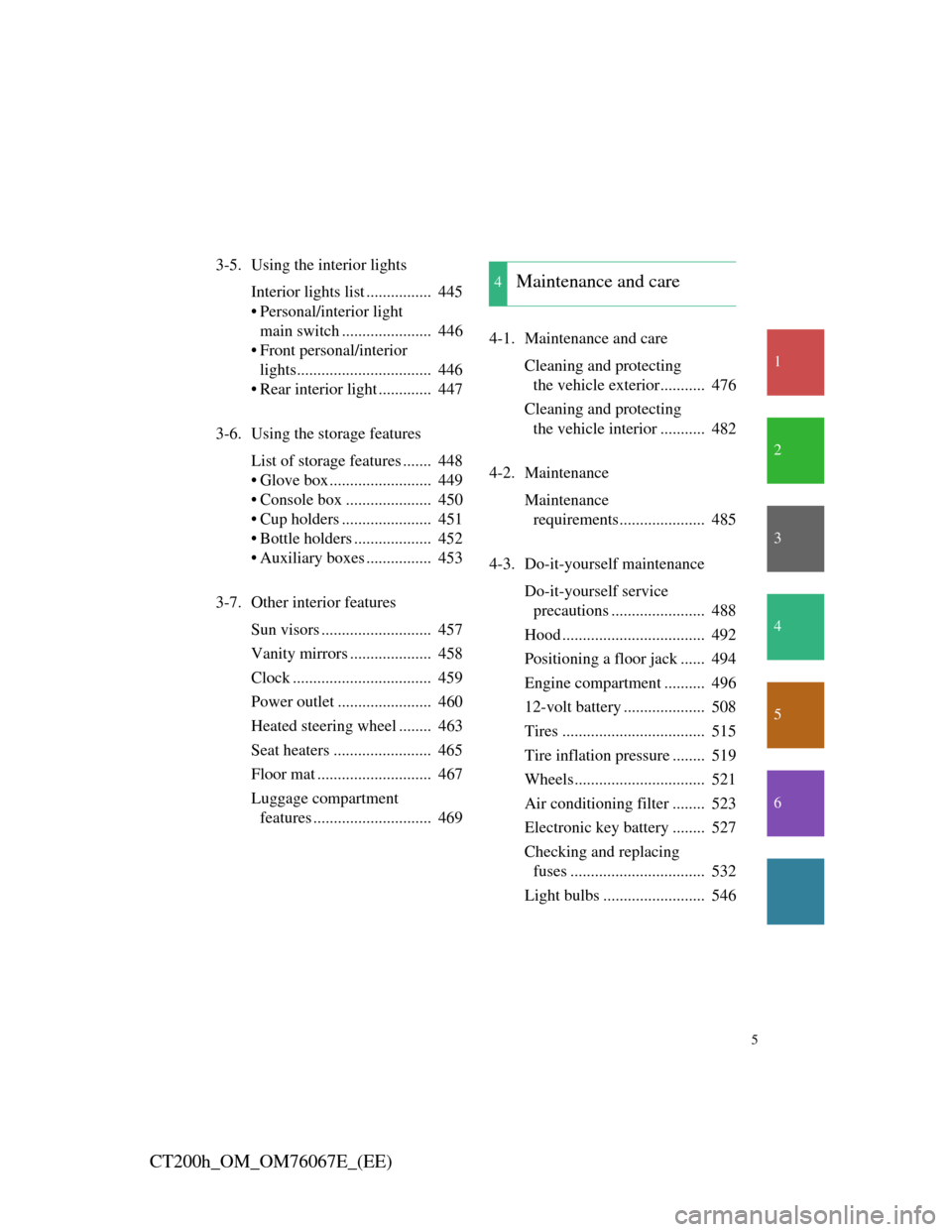
1
2
3
4
5
6
5
CT200h_OM_OM76067E_(EE)
3-5. Using the interior lights
Interior lights list ................ 445
• Personal/interior light
main switch ...................... 446
• Front personal/interior
lights................................. 446
• Rear interior light ............. 447
3-6. Using the storage features
List of storage features ....... 448
• Glove box ......................... 449
• Console box ..................... 450
• Cup holders ...................... 451
• Bottle holders ................... 452
• Auxiliary boxes ................ 453
3-7. Other interior features
Sun visors ........................... 457
Vanity mirrors .................... 458
Clock .................................. 459
Power outlet ....................... 460
Heated steering wheel ........ 463
Seat heaters ........................ 465
Floor mat ............................ 467
Luggage compartment
features ............................. 4694-1. Maintenance and care
Cleaning and protecting
the vehicle exterior........... 476
Cleaning and protecting
the vehicle interior ........... 482
4-2. Maintenance
Maintenance
requirements..................... 485
4-3. Do-it-yourself maintenance
Do-it-yourself service
precautions ....................... 488
Hood ................................... 492
Positioning a floor jack ...... 494
Engine compartment .......... 496
12-volt battery .................... 508
Tires ................................... 515
Tire inflation pressure ........ 519
Wheels................................ 521
Air conditioning filter ........ 523
Electronic key battery ........ 527
Checking and replacing
fuses ................................. 532
Light bulbs ......................... 546
4Maintenance and care
Page 38 of 710
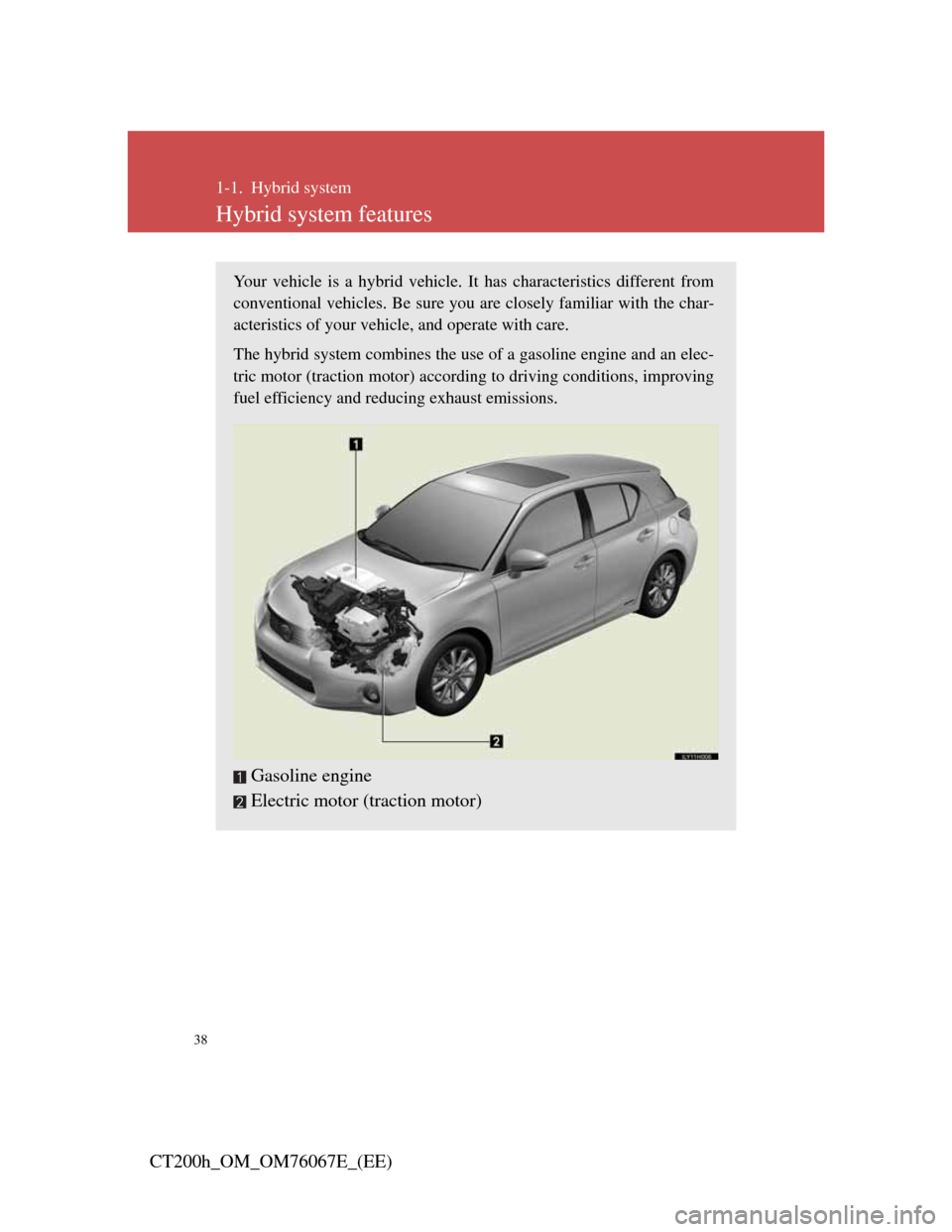
38
CT200h_OM_OM76067E_(EE)
1-1. Hybrid system
Hybrid system features
Your vehicle is a hybrid vehicle. It has characteristics different from
conventional vehicles. Be sure you are closely familiar with the char-
acteristics of your vehicle, and operate with care.
The hybrid system combines the use of a gasoline engine and an elec-
tric motor (traction motor) according to driving conditions, improving
fuel efficiency and reducing exhaust emissions.
Gasoline engine
Electric motor (traction motor)
Page 39 of 710
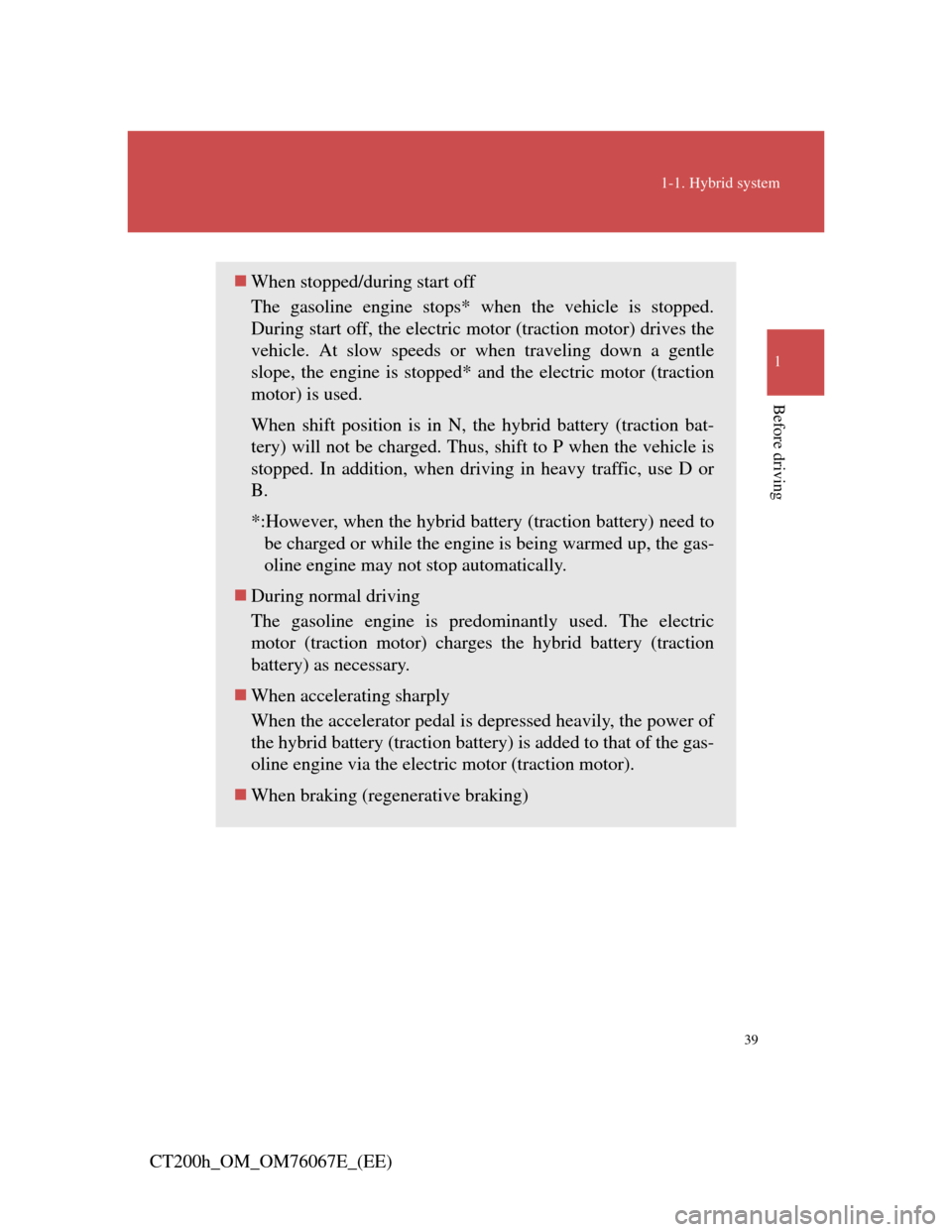
39
1-1. Hybrid system
1
Before driving
CT200h_OM_OM76067E_(EE)
When stopped/during start off
The gasoline engine stops* when the vehicle is stopped.
During start off, the electric motor (traction motor) drives the
vehicle. At slow speeds or when traveling down a gentle
slope, the engine is stopped* and the electric motor (traction
motor) is used.
When shift position is in N, the hybrid battery (traction bat-
tery) will not be charged. Thus, shift to P when the vehicle is
stopped. In addition, when driving in heavy traffic, use D or
B.
*:However, when the hybrid battery (traction battery) need to
be charged or while the engine is being warmed up, the gas-
oline engine may not stop automatically.
During normal driving
The gasoline engine is predominantly used. The electric
motor (traction motor) charges the hybrid battery (traction
battery) as necessary.
When accelerating sharply
When the accelerator pedal is depressed heavily, the power of
the hybrid battery (traction battery) is added to that of the gas-
oline engine via the electric motor (traction motor).
When braking (regenerative braking)
Page 40 of 710
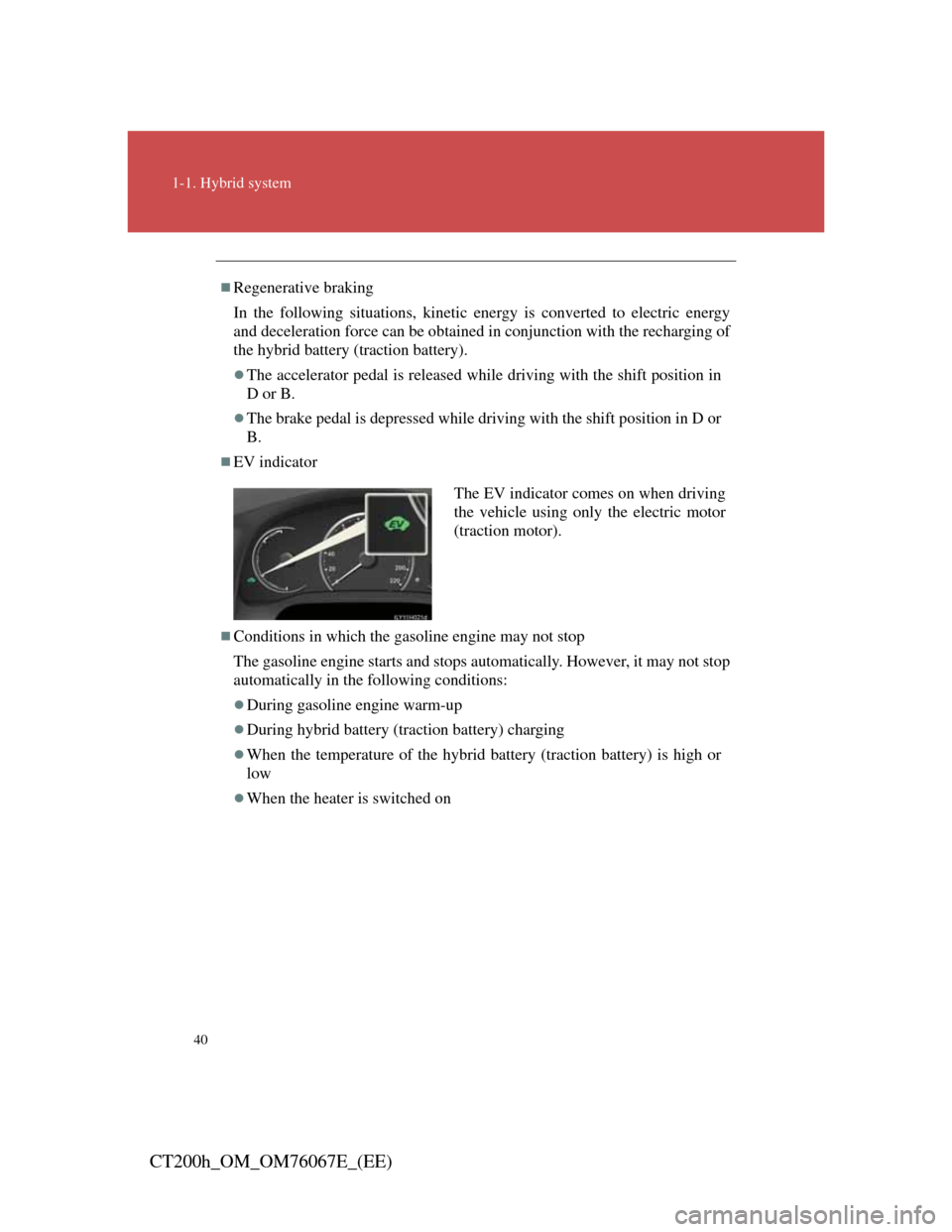
40
1-1. Hybrid system
CT200h_OM_OM76067E_(EE)
Regenerative braking
In the following situations, kinetic energy is converted to electric energy
and deceleration force can be obtained in conjunction with the recharging of
the hybrid battery (traction battery).
The accelerator pedal is released while driving with the shift position in
D or B.
The brake pedal is depressed while driving with the shift position in D or
B.
EV indicator
Conditions in which the gasoline engine may not stop
The gasoline engine starts and stops automatically. However, it may not stop
automatically in the following conditions:
During gasoline engine warm-up
During hybrid battery (traction battery) charging
When the temperature of the hybrid battery (traction battery) is high or
low
When the heater is switched on
The EV indicator comes on when driving
the vehicle using only the electric motor
(traction motor).
Page 41 of 710

41
1-1. Hybrid system
1
Before driving
CT200h_OM_OM76067E_(EE)
Charging the hybrid battery (traction battery)
As the gasoline engine charges the hybrid battery (traction battery), the
battery does not need to be charged from an outside source. However, if
the vehicle is left parked for a long time the hybrid battery will slowly
discharge. For this reason, be sure to drive the vehicle at least once every
few months for at least 30 minutes or 16 km (10 miles). If the hybrid bat-
tery becomes fully discharged and you are unable to jump-start the vehi-
cle with the 12-volt battery, contact any authorized Lexus dealer or
repairer, or another duly qualified and equipped professional.
If the shift position is in N, the hybrid battery (traction battery) will not
be charged. Always shift the shift position in P when the vehicle is
stopped. When driving in heavy traffic, operate the vehicle with the shift
position in D or B to avoid discharging the hybrid battery (traction bat-
tery).
Charging the 12-volt battery
P. 6 3 6
After the 12-volt battery has discharged or has been changed or removed
The gasoline engine may not stop even if the vehicle is running on the
hybrid battery (traction battery). If this continues for a few days, contact any
authorized Lexus dealer or repairer, or another duly qualified and equipped
professional.
Page 42 of 710
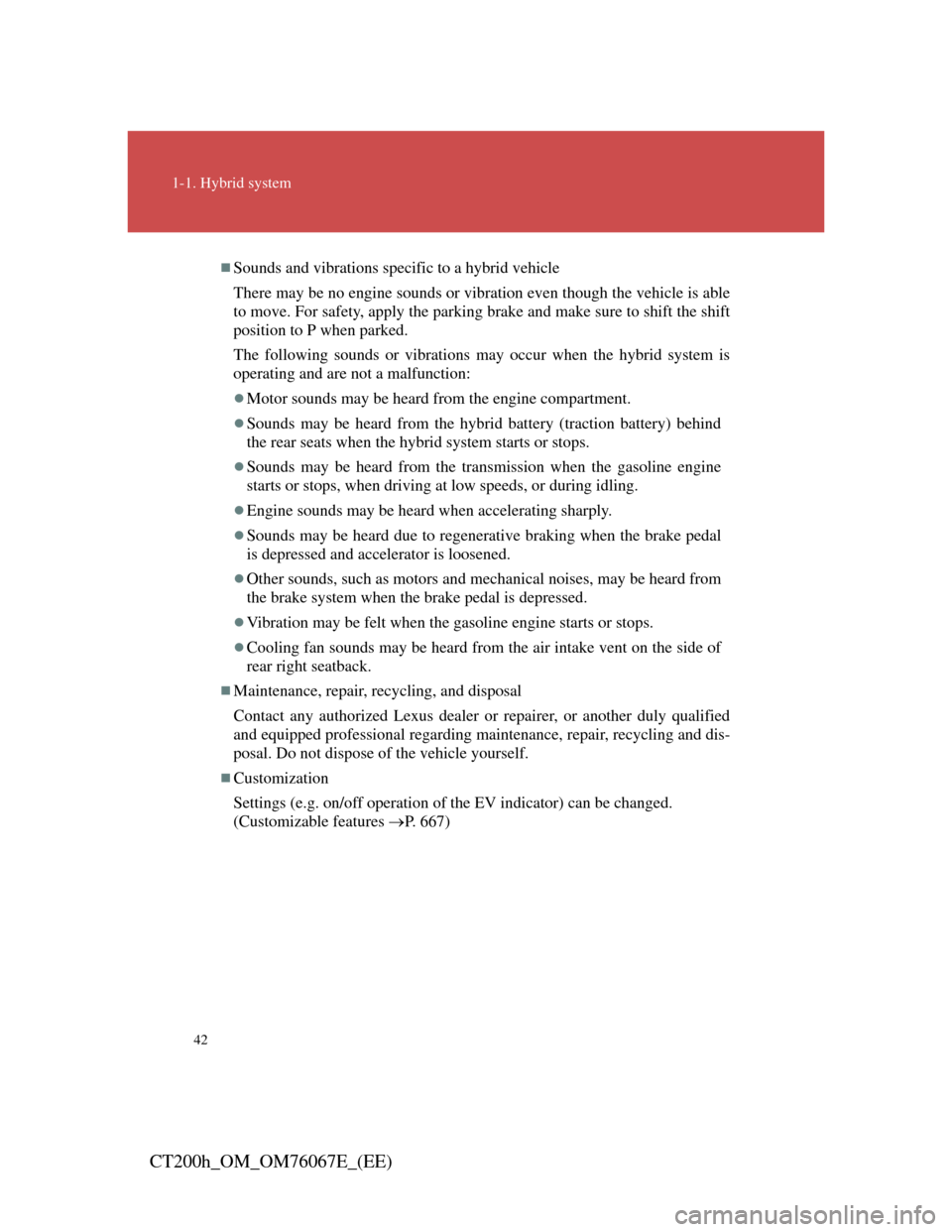
42
1-1. Hybrid system
CT200h_OM_OM76067E_(EE)
Sounds and vibrations specific to a hybrid vehicle
There may be no engine sounds or vibration even though the vehicle is able
to move. For safety, apply the parking brake and make sure to shift the shift
position to P when parked.
The following sounds or vibrations may occur when the hybrid system is
operating and are not a malfunction:
Motor sounds may be heard from the engine compartment.
Sounds may be heard from the hybrid battery (traction battery) behind
the rear seats when the hybrid system starts or stops.
Sounds may be heard from the transmission when the gasoline engine
starts or stops, when driving at low speeds, or during idling.
Engine sounds may be heard when accelerating sharply.
Sounds may be heard due to regenerative braking when the brake pedal
is depressed and accelerator is loosened.
Other sounds, such as motors and mechanical noises, may be heard from
the brake system when the brake pedal is depressed.
Vibration may be felt when the gasoline engine starts or stops.
Cooling fan sounds may be heard from the air intake vent on the side of
rear right seatback.
Maintenance, repair, recycling, and disposal
Contact any authorized Lexus dealer or repairer, or another duly qualified
and equipped professional regarding maintenance, repair, recycling and dis-
posal. Do not dispose of the vehicle yourself.
Customization
Settings (e.g. on/off operation of the EV indicator) can be changed.
(Customizable features P. 667)
Page 51 of 710
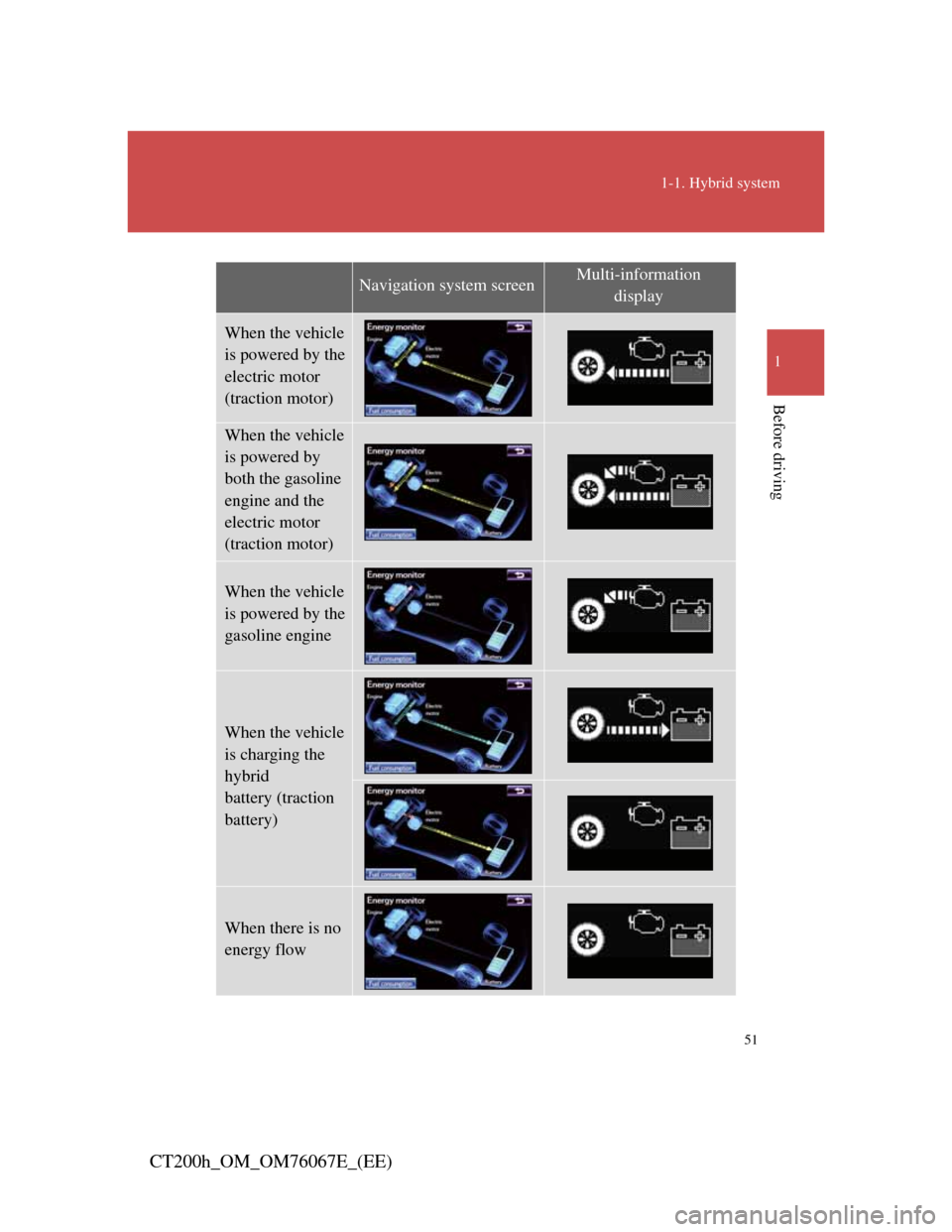
51
1-1. Hybrid system
1
Before driving
CT200h_OM_OM76067E_(EE)
Navigation system screenMulti-information
display
When the vehicle
is powered by the
electric motor
(traction motor)
When the vehicle
is powered by
both the gasoline
engine and the
electric motor
(traction motor)
When the vehicle
is powered by the
gasoline engine
When the vehicle
is charging the
hybrid
battery (traction
battery)
When there is no
energy flow
Page 55 of 710
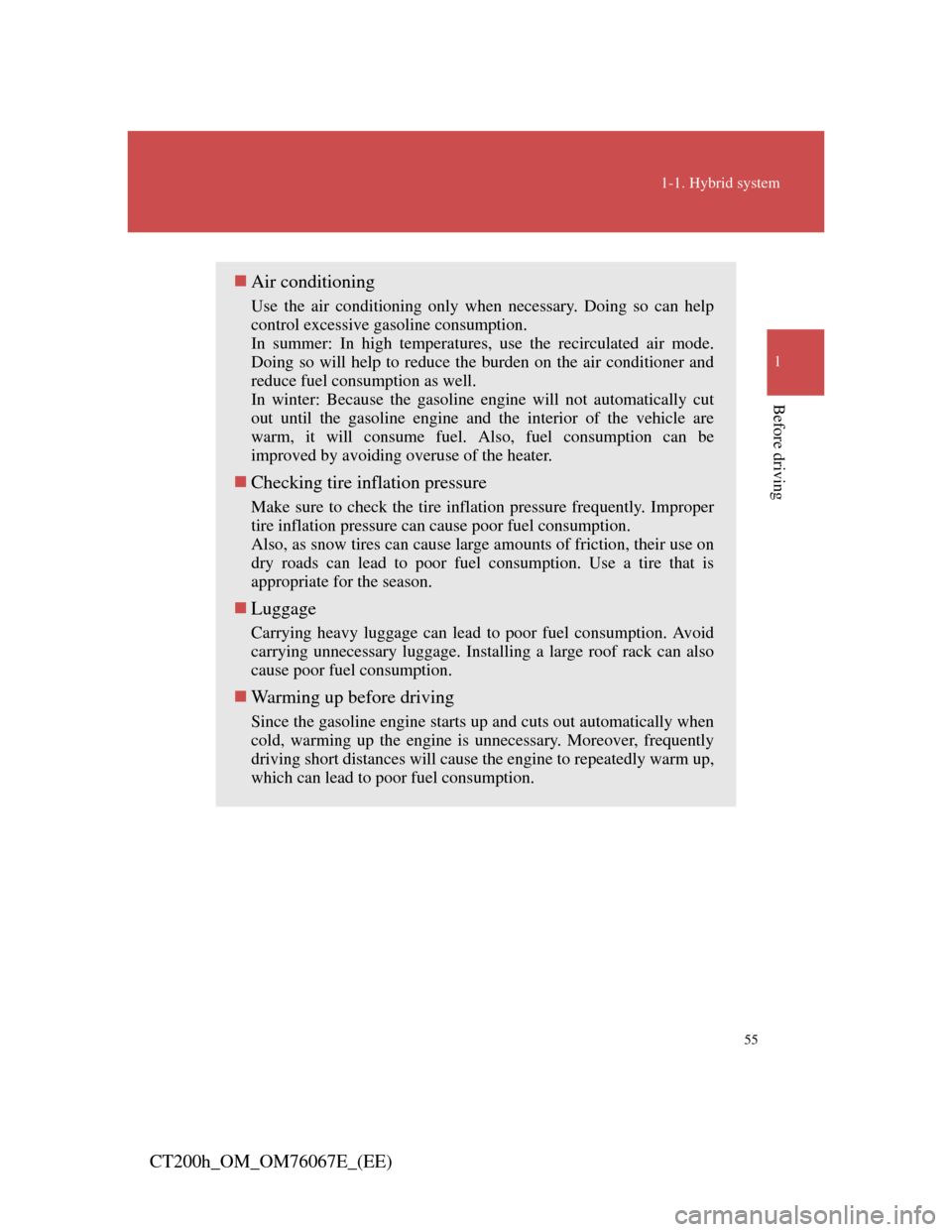
55
1-1. Hybrid system
1
Before driving
CT200h_OM_OM76067E_(EE)
Air conditioning
Use the air conditioning only when necessary. Doing so can help
control excessive gasoline consumption.
In summer: In high temperatures, use the recirculated air mode.
Doing so will help to reduce the burden on the air conditioner and
reduce fuel consumption as well.
In winter: Because the gasoline engine will not automatically cut
out until the gasoline engine and the interior of the vehicle are
warm, it will consume fuel. Also, fuel consumption can be
improved by avoiding overuse of the heater.
Checking tire inflation pressure
Make sure to check the tire inflation pressure frequently. Improper
tire inflation pressure can cause poor fuel consumption.
Also, as snow tires can cause large amounts of friction, their use on
dry roads can lead to poor fuel consumption. Use a tire that is
appropriate for the season.
Luggage
Carrying heavy luggage can lead to poor fuel consumption. Avoid
carrying unnecessary luggage. Installing a large roof rack can also
cause poor fuel consumption.
Warming up before driving
Since the gasoline engine starts up and cuts out automatically when
cold, warming up the engine is unnecessary. Moreover, frequently
driving short distances will cause the engine to repeatedly warm up,
which can lead to poor fuel consumption.
Page 132 of 710
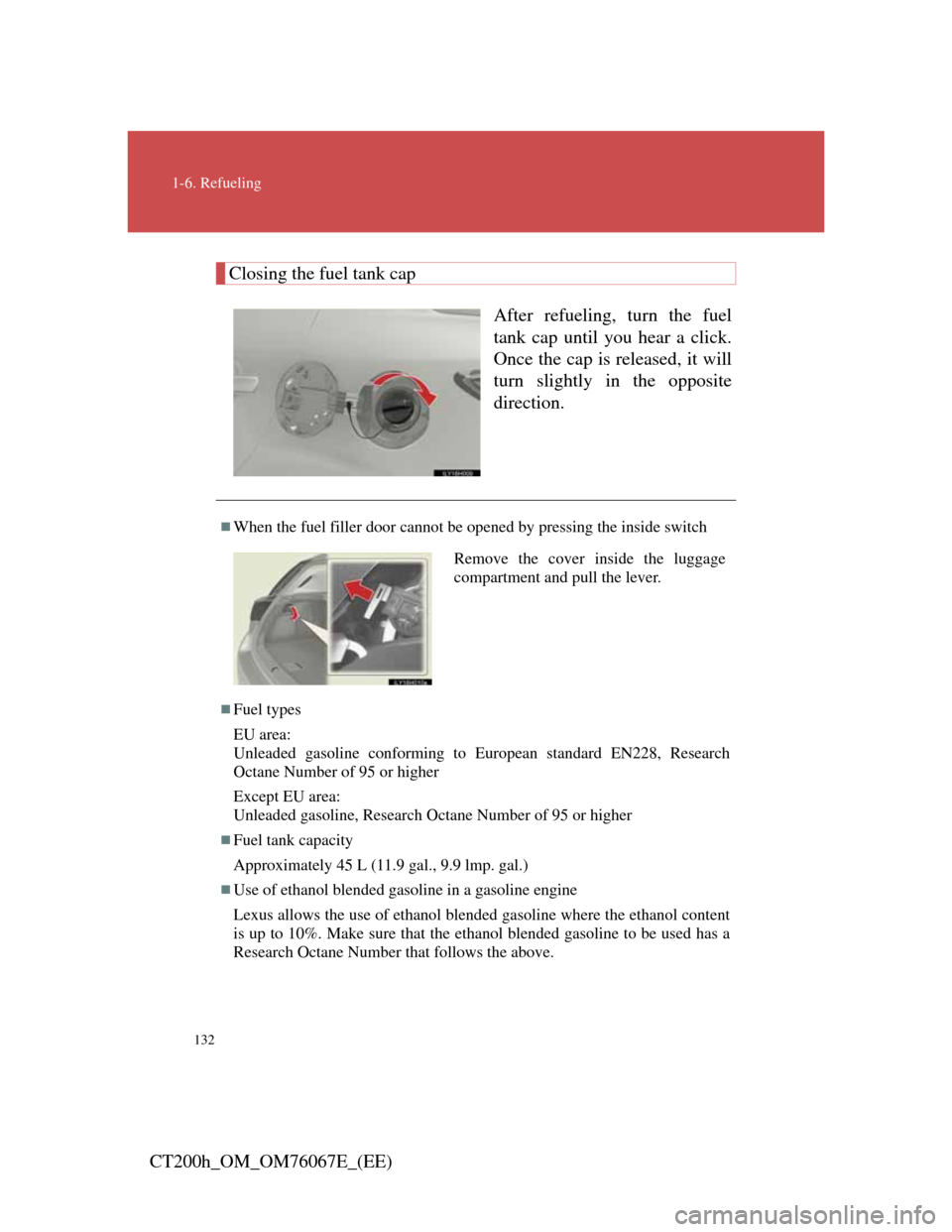
132
1-6. Refueling
CT200h_OM_OM76067E_(EE)
Closing the fuel tank cap
After refueling, turn the fuel
tank cap until you hear a click.
Once the cap is released, it will
turn slightly in the opposite
direction.
When the fuel filler door cannot be opened by pressing the inside switch
Fuel types
EU area:
Unleaded gasoline conforming to European standard EN228, Research
Octane Number of 95 or higher
Except EU area:
Unleaded gasoline, Research Octane Number of 95 or higher
Fuel tank capacity
Approximately 45 L (11.9 gal., 9.9 lmp. gal.)
Use of ethanol blended gasoline in a gasoline engine
Lexus allows the use of ethanol blended gasoline where the ethanol content
is up to 10%. Make sure that the ethanol blended gasoline to be used has a
Research Octane Number that follows the above.
Remove the cover inside the luggage
compartment and pull the lever.
Page 188 of 710

188
2-1. Driving procedures
CT200h_OM_OM76067E_(EE)
Breaking in your new Lexus
To extend the life of the vehicle, observing the following precautions is rec-
ommended:
For the first 300 km (200 miles):
Avoid sudden stops.
For the first 2000 km (1200 miles):
• Do not drive at extremely high speeds.
• Avoid sudden acceleration.
• Do not drive at a constant speed for extended periods.
Operating your vehicle in a foreign country
Comply with the relevant vehicle registration laws and confirm the avail-
ability of the correct fuel. (P. 6 5 3 )
For efficient use
Shift the shift position to D when driving.
In the N position, the gasoline engine operates but electricity cannot be
generated. The hybrid battery (traction battery) will discharge, requiring
unnecessary engine power to recharge.
Drive your vehicle smoothly.
Avoid abrupt acceleration and deceleration. Gradual acceleration and
deceleration will make more effective use of the electric motor (traction
motor) without having to use gasoline engine power.
Avoid repeated acceleration.
Repeated acceleration consumes hybrid battery (traction battery) power,
resulting in poor acceleration. Battery power can be restored by driving
with the accelerator pedal slightly released.
Shift the shift position to P when parking.
In the N position, the hybrid battery (traction battery) does not recharge.
Leaving the shift position in the N position for an extended period of
time may discharge the hybrid battery (traction battery). The vehicle
cannot run if the hybrid battery (traction battery) is discharged.